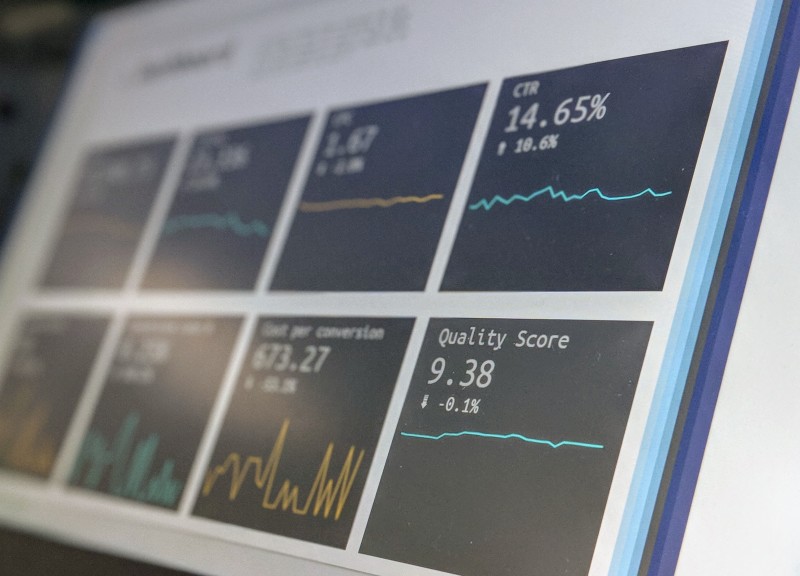In the competitive landscape of Software as a Service (SaaS), measuring success and making data-driven decisions are crucial for companies to thrive. To achieve this, SaaS companies can leverage the power of Objectives and Key Results (OKRs) and Key Performance Indicators (KPIs). In this article, we will explore the importance of OKRs and KPIs in measuring success, the unique challenges faced by SaaS companies, key metrics specific to the SaaS industry, the impact of pricing and customer success on metrics, best practices for good measurability, and how airfocus can assist in implementing effective OKR and KPI frameworks.
First, let’s define them
OKRs (Objectives and Key Results) and KPIs (Key Performance Indicators) are two widely used performance measurement frameworks that play a vital role in measuring success within organizations. OKRs (Objectives and Key Results) provide a way to set ambitious goals and define measurable results that align with the organization's strategic priorities. KPIs (Key Performance Indicators) are specific metrics that indicate how well a company is performing against its objectives.
OKRs are a goal-setting methodology that helps organizations define and track their objectives and the key results they aim to achieve. Objectives are high-level, aspirational goals that provide a sense of direction and purpose. They answer the question, "What do we want to accomplish?" KPIs, on the other hand, are quantifiable metrics that are used to assess the performance of an organization, team, or individual.
The main difference between OKRs and KPIs lies in their scope and level of granularity. OKRs are broader, high-level goals that set the direction and provide focus for an organization, while KPIs are more specific metrics that measure the performance of individual activities or processes within the organization.
Both OKRs and KPIs are important in measuring success for several reasons. Firstly, they provide a framework for setting clear goals and defining measurable outcomes. By aligning efforts and resources towards these objectives and key results, organizations can prioritize their activities and track progress effectively. Secondly, OKRs and KPIs promote transparency and accountability within teams and organizations. They create a shared understanding of what needs to be achieved and hold individuals and teams responsible for their contributions. Lastly, OKRs and KPIs facilitate data-driven decision-making. By measuring and analyzing relevant metrics, organizations can gain insights into their performance, identify areas for improvement, and make informed decisions to drive success.

Challenges for SaaS companies
SaaS (Software as a Service) companies face unique challenges that make OKRs and KPIs particularly important for measuring success and driving growth. Additionally, data-driven decision-making plays a crucial role in the success of SaaS companies. Here are some reasons why:
Recurring revenue growth: SaaS companies operate on a subscription-based model, where recurring revenue is vital for sustainability and expansion. OKRs and KPIs help track metrics like Monthly Recurring Revenue (MRR), Customer Lifetime Value (CLTV), and Churn Rate, providing insights into revenue growth and customer retention.
Customer-centric focus: Customer satisfaction and retention are critical for SaaS success. OKRs and KPIs enable SaaS companies to measure Customer Satisfaction Scores (CSAT), Net Promoter Scores (NPS), and other customer-centric metrics. These metrics help evaluate the effectiveness of customer success initiatives and guide improvements in product development, support, and user experience.
Market differentiation: The SaaS market is highly competitive, with numerous players offering similar solutions. OKRs and KPIs aid in defining unique value propositions and tracking metrics that differentiate the product or service.
Scalability and efficiency: OKRs and KPIs enable SaaS companies to scale their operations efficiently. KPIs related to Customer Acquisition Cost (CAC) and Customer Success Efficiency Ratio (CSER) help monitor the cost-effectiveness of acquiring and retaining customers, ensuring sustainable growth.
Data-driven decision-making: SaaS companies deal with vast amounts of data generated from user interactions, product usage, and market trends. Data-driven decision-making is essential to extract valuable insights and make informed choices.
Key metrics for SaaS products
There are several key metrics that are essential for measuring the success and performance of SaaS products. Here are some of the key metrics for SaaS products:
Monthly recurring revenue (MRR): MRR is the predictable revenue generated from subscription fees on a monthly basis.
Customer acquisition cost (CAC): CAC measures the cost of acquiring a new customer.
Churn rate: Churn Rate measures the percentage of customers who cancel or do not renew their subscriptions over a specific period.
Customer lifetime value (CLTV): CLTV represents the estimated revenue a customer will generate throughout their relationship with the company.
Net Promoter Score (NPS): NPS measures customer satisfaction and loyalty by asking customers to rate their likelihood of recommending the product to others.
Active users and engagement: Active Users and Engagement metrics help assess how customers are utilizing the product and how frequently they are engaging with it.
Conversion rate: Conversion Rate measures the percentage of leads or trial users who convert into paying customers.
Average revenue per user (ARPU): ARPU measures the average revenue generated per user or customer.
Customer health score: Customer Health Score is an indicator that combines various customer-related metrics, such as usage patterns, support interactions, and feedback, to assess the overall health and satisfaction of customers.
Product adoption and onboarding metrics: These metrics measure how effectively users are adopting and onboarding the product.

Impact of pricing and customer success on metrics
Pricing and customer success play significant roles in influencing the metrics of a SaaS product. Here's a closer look at how these factors can impact various metrics:
Pricing directly affects revenue-related metrics such as Monthly Recurring Revenue (MRR), Average Revenue per User (ARPU), and Customer Lifetime Value (CLTV). By setting the right pricing strategy, a SaaS company can optimize these metrics and ensure sustainable growth. Pricing has a direct impact on CAC. If the pricing is too high, it may increase customer acquisition costs, making it challenging to acquire new customers. On the other hand, if the pricing is too low, it may attract customers with a low CLTV, resulting in lower profitability.
An effective customer success strategy can have a positive impact on reducing churn rate. By providing exceptional support, onboarding, and ongoing engagement, customer success teams can improve customer satisfaction, increase product adoption, and reduce the likelihood of customers canceling their subscriptions.
Pricing can directly impact the conversion rate of trial users or leads into paying customers. An optimal pricing strategy aligned with customer expectations and perceived value can improve conversion rates, attracting more customers to make a purchase decision. Effective pricing strategies and customer success initiatives can create opportunities for upselling and expansion within existing customer accounts. By offering additional features, upgrades, or higher-tier plans, SaaS companies can increase revenue from existing customers.
Pricing fairness and customer success efforts have a direct impact on customer satisfaction and retention. When customers perceive the value received from the product to align with the price paid and experience a high level of support and success, they are more likely to remain loyal and continue their subscriptions.
Best practices for good measurability
When approaching metrics in a SaaS context, it is essential to establish "good measurability" by following best practices. Here are some best practices for achieving good measurability in a SaaS environment:
Define clear objectives: Start by defining clear objectives and goals that align with your overall business strategy. Clearly articulate what you aim to achieve with the metrics you track.
Select relevant metrics: Choose metrics that directly align with your objectives and provide actionable insights. Avoid tracking metrics simply for the sake of measurement.
Establish a data infrastructure: Build a robust data infrastructure that allows you to collect, store, and analyze data effectively.
Ensure data accuracy and consistency: Data accuracy is crucial for reliable metrics. Establish data quality controls and regularly validate the accuracy and consistency of your data sources.
Set baselines and targets: Establish baseline measurements and set targets or benchmarks for your metrics.
Regularly review and refine metrics: Continuously review and refine your metrics to ensure they remain relevant and aligned with your evolving business needs.
Establish data accessibility and visualization: Make metrics easily accessible to relevant stakeholders within your organization.
Foster a culture of measurement: Instill a culture of measurement within your organization. Encourage teams to actively engage with metrics, interpret the data, and use it to inform their decision-making and actions.
Regularly communicate and share insights: Regularly communicate metric updates and insights with relevant stakeholders.
Continuously iterate and improve: Embrace a mindset of continuous improvement when it comes to your metrics. Regularly review and refine your measurement framework based on feedback, learnings, and changing business needs.
How airfocus can help
airfocus is a powerful platform that can assist you in effectively managing your OKRs (Objectives and Key Results) and KPIs (Key Performance Indicators) in a seamless and efficient manner. Here's how airfocus can help you:
Prioritizing: airfocus provides a comprehensive framework for prioritization. It enables you to evaluate and prioritize your objectives, initiatives, and features based on various factors such as strategic alignment, impact, effort, and customer value.
One home for your product(s): With airfocus, you can centralize all your product-related information in one place. It serves as a single source of truth for your OKRs, KPIs, roadmaps, and other product management artifacts.
OKR template: airfocus offers pre-built OKR template that guide you through the process of defining and setting objectives, key results, and initiatives. These templates provide a structured approach and best practices to help you create meaningful OKRs that drive results.
Modularity: airfocus allows you to break down your OKRs and initiatives into smaller, manageable pieces. You can create hierarchies, set dependencies, and visualize the relationships between different elements.
Portal and Insights for Customer Feedback: airfocus integrates with various customer feedback tools, allowing you to gather and analyze customer insights directly within the platform. Plus it offers you features like Portals and Insights to help you gather and analyze customer feedback easily and efficiently.
Roadmap visualization: With airfocus, you can create visual roadmaps that provide a clear overview of your product strategy, objectives, and key initiatives.
Collaboration and transparency: airfocus promotes collaboration and transparency among team members and stakeholders. It allows for real-time collaboration, comments, and discussions on objectives, initiatives, and priorities.
Analytics and Insights: airfocus provides analytics and reporting features that give you actionable insights into the performance of your OKRs and KPIs. You can track progress, measure results, and visualize the impact of your initiatives.
Conclusion
In the dynamic and competitive landscape of the SaaS industry, measuring success and making data-driven decisions are essential for sustainable growth. By adopting OKRs and KPIs, SaaS companies can set ambitious goals, track progress, and optimize performance. With the right metrics in place and a focus on factors such as pricing and customer success, SaaS companies can gain valuable insights and drive long-term success. By leveraging tools like airfocus, organizations can streamline their OKR and KPI processes, enabling effective prioritization and decision-making, ultimately leading to enhanced performance and customer satisfaction.

Vishal Chaudhary

Read also
Experience the new way of doing product management





